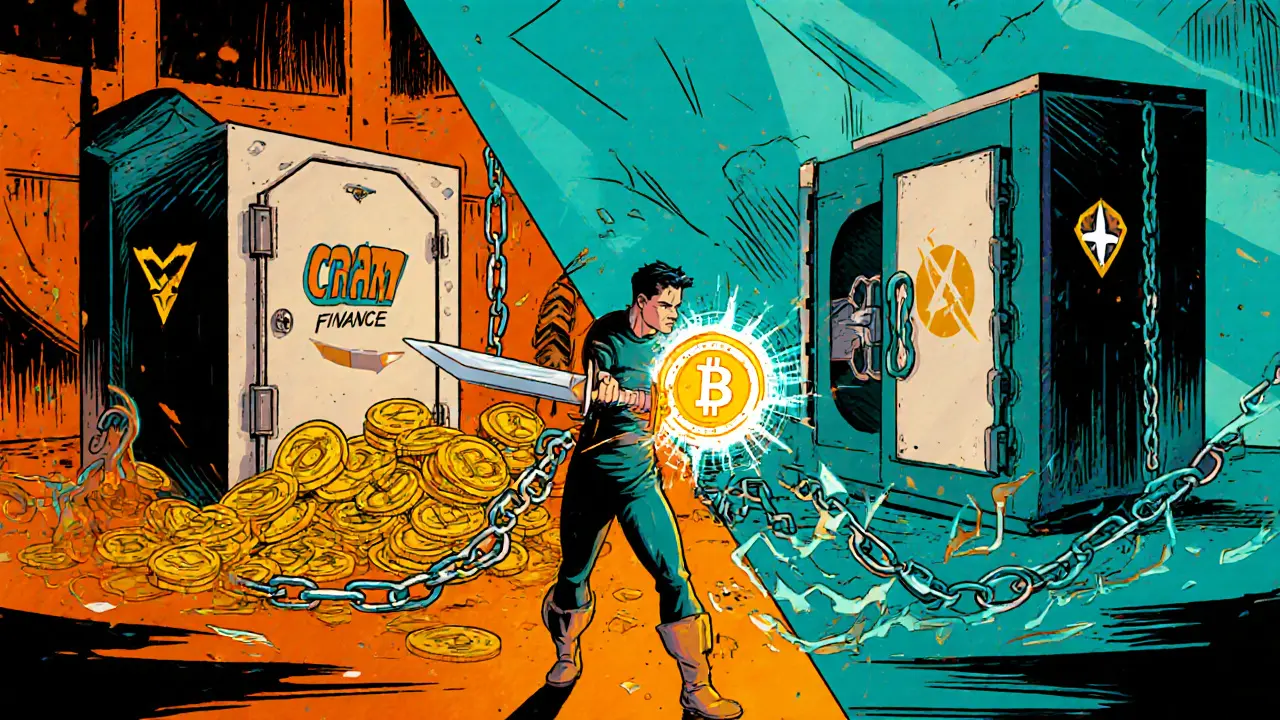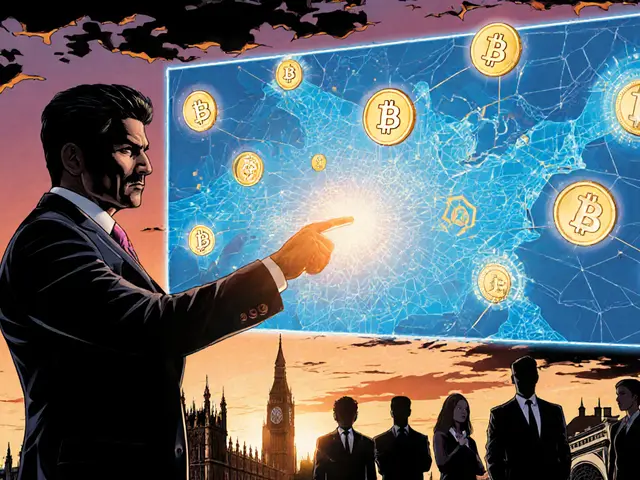Crema Finance Review: Deep Dive into This DeFi Platform
C.R.E.A.M. Finance Token Valuation Calculator
Token Value Analysis
Estimated market cap: $2,000,000
Token price per unit: $1.10
Total circulating supply: 1,855,660 CREAM
Yield Potential
Effective APY with rewards: 33.5%
Annual rewards value: $600,000
Projected 1-year return: $220,000
When you type “Crema Finance crypto exchange review” into Google, the first thing you’ll see is a flood of data about C.R.E.A.M. Finance - a DeFi lending protocol that dabbles in DEX‑style swaps. It’s not a classic order‑book exchange, but many users treat it like one because you can trade, borrow, and earn on the same interface. This article strips away the hype, walks through the platform’s history, core features, security record, token economics, and even pits it against rivals like Aave and Compound. By the end you’ll know whether the Crema Finance review deserves a spot in your portfolio or if the risks outweigh the rewards.
TL;DR
- C.R.E.A.M. Finance is a multi‑chain DeFi lending protocol that also offers AMM‑style swaps.
- Founded by Jeffrey Huang in 2021, it forks Compound for lending and Balancer for swapping.
- Supports Ethereum, BNB Chain, Polygon, Fantom, Arbitrum, and Base.
- Security has improved after 2021‑22 exploits, with audits from SlowMist and MixBytes and a triple‑oracle price feed.
- CREAM token trades around $1.10, market cap ~$2M, and carries high volatility; compare with Aave’s $70‑$80 range.
What Is C.R.E.A.M. Finance?
C.R.E.A.M. Finance is a decentralized finance platform that blends lending, borrowing, and automated market‑making (AMM) into a single interface. The acronym stands for “Crypto Rules Everything Around Me.” Launched in August 2021, the protocol builds on the codebases of Compound Finance (for its money market) and Balancer Labs (for its swap engine). By forking these proven projects, C.R.E.A.M. offers familiar mechanics while adding support for riskier assets like Yearn vault tokens (yvDAI, yvUSDC), Curve LP tokens, and interest‑bearing tokens (aTokens, cTokens).
Team, Vision, and Governance
The core team is lean: founder Jeffrey Huang plus three developers with deep CS backgrounds. One of them previously contributed to OmiseGo and Ethereum’s core tooling. The protocol’s governance token, CREAM, lets holders vote on asset whitelisting, fee structures, and future upgrades. Huang often emphasizes financial inclusion - the idea that anyone with an internet connection should access low‑cost credit without a bank.
Core Features at a Glance
- Lending & Borrowing: Users supply crypto to earn interest (supply APY) and can borrow against collateral at variable rates.
- AMM Swaps: Powered by a Balancer‑style pool, users can swap between supported assets without leaving the app.
- Liquidity Mining: CREAM rewards are distributed to suppliers and borrowers, augmenting native interest.
- Cross‑Chain Access: Deployments on Ethereum, BNB Chain, Polygon, Fantom, Arbitrum, and Base ensure lower gas fees on Layer‑2s.
Multi‑Chain Deployment Details
By 2025 C.R.E.A.M. operates on six EVM‑compatible networks. Each chain hosts its own set of market contracts, but the user experience remains unified through the web UI. On Polygon and BNB Chain, transaction fees average under $0.001, making small‑scale lending viable. On Ethereum, gas spikes still affect heavy borrowers, but the protocol’s integration with Chainlink price oracles helps mitigate price manipulation during volatile periods.
Security Track Record
Two high‑profile exploits in 2021 and 2022 forced an overhaul of the price‑oracle architecture. Since then, C.R.E.A.M. employs a redundancy system that pulls data from Chainlink, Band, and an internal fallback. Flash‑loan caps were introduced to curb attack vectors that rely on rapid borrowing and price manipulation. Audits are performed bi‑monthly by SlowMist and MixBytes, with the latest reports (Q22025) showing no critical vulnerabilities.

Tokenomics & Market Snapshot (Oct2025)
CREAM’s circulating supply sits at 1,855,660 tokens, representing a market cap of roughly $2M. The token trades near $1.09, having slipped 4.36% over the past week. Analysts predict a short‑term range of $45‑$48 for the token’s “fair value” based on projected TVL growth, but these numbers assume a massive uptick in user adoption - a scenario many consider speculative. The governance model allocates 30% of the supply to liquidity mining, 20% to the core team (vested over four years), and the remainder to community incentives and reserves.
How Does C.R.E.A.M. Compare to the Big Players?
| Feature | C.R.E.A.M. Finance | Aave | Compound |
|---|---|---|---|
| Core Model | Compound fork + Balancer‑style AMM | Original Money Market + V3 liquidity pool | Pure Compound fork |
| Supported Chains (2025) | Ethereum, BNB Chain, Polygon, Fantom, Arbitrum, Base | Ethereum, Polygon, Avalanche, Fantom | Ethereum, BNB Chain |
| Typical Supply APY (USDC) | 3‑4% | 4‑5% | 2‑3% |
| Borrow APR (USDC) | 5‑6% | 6‑7% | 5‑6% |
| Liquidity Mining Rewards | CREAM token (30% annual) | AAVE token (15% annual) | None (no native rewards) |
| Audits (2025) | SlowMist, MixBytes (bi‑monthly) | Quantstamp, PeckShield (annual) | OpenZeppelin (annual) |
| Governance Model | Token‑based voting, 2‑day quorum | Token‑based, 3‑day quorum | Token‑based, 1‑day quorum |
From the table you can see C.R.E.A.M.’s biggest edge is its cross‑chain reach and the extra AMM functionality. However, Aave still leads on raw APY numbers and has a larger, more mature user base. Compound remains the simplest option for pure lending without the extra swap layer.
User Experience, Fees, and Interface
The web UI feels like a hybrid of a DeFi dashboard and a small crypto exchange. Wallet connection works with MetaMask, Trust Wallet, and WalletConnect. Transaction fees are network‑dependent; on Polygon a swap costs less than $0.0005, while on Ethereum you’ll pay the usual gas price. C.R.E.A.M. does not charge a platform fee on swaps - the AMM pool’s fee (0.30%) is shared with liquidity providers. Lending and borrowing incur a 0.05% protocol fee, which is lower than Aave’s 0.09% on the same networks.
Pros & Cons - Quick Verdict
- Pros:
- Multi‑chain deployment reduces gas costs.
- Combined lending + swap interface simplifies asset management.
- Active audit schedule with reputable firms.
- Liquidity mining rewards can boost effective yields.
- Cons:
- Token price is extremely volatile; market cap under $3M limits liquidity.
- History of exploits raises lingering trust concerns.
- Governance participation is low; proposals often stall.
- Complexity of supporting many asset types can confuse newcomers.
Is C.R.E.A.M. Finance an Exchange?
Technically, it’s not a traditional exchange that matches buyers and sellers via an order book. Instead, it offers an AMM‑style swap that functions similarly to a DEX. Users can trade assets instantly, but prices are derived from pool balances rather than market depth. For people looking for a one‑stop shop to earn interest and swap tokens without hopping between apps, C.R.E.A.M. feels exchange‑ish. For pure traders seeking deep liquidity and tight spreads, dedicated DEXes like Uniswap or Sushiswap still have an edge.
Future Outlook (2026 and Beyond)
Road‑map items for 2026 include a native layer‑2 rollout on Optimism, expanded support for stablecoin‑only pools, and an NFT‑collateral lending pilot. If the team can attract institutional liquidity, the protocol’s TVL could climb past $500M, pushing CREAM token valuation higher. Conversely, any new exploit could erode confidence quickly, given the platform’s modest market cap. Keep an eye on audit reports and governance votes - they’re the best early warnings.
Frequently Asked Questions
Is C.R.E.A.M. Finance a safe place to deposit my crypto?
Safety is relative. The protocol has undergone multiple audits after past exploits, and it now uses a triple‑oracle price feed. However, the platform’s total value locked (TVL) is lower than industry leaders, meaning a breach could have outsized impact. Use only funds you can afford to lose and consider diversifying across more established platforms.
How do I earn CREAM rewards?
Supply assets to the lending markets or borrow against collateral, then stake the received CREAM tokens in the reward pool. Rewards are distributed weekly based on your share of the total supplied/borrowed amount.
Can I use C.R.E.A.M. on a mobile device?
Yes. The web UI is responsive and works with mobile wallets like MetaMask Mobile, Trust Wallet, and Coinbase Wallet via WalletConnect.
What chains offer the lowest fees for C.R.E.A.M. transactions?
Polygon and Base currently provide the cheapest gas, often under $0.001 per transaction. BNB Chain is also low‑cost, while Ethereum remains the most expensive.
How does C.R.E.A.M. differ from Aave?
Aave focuses purely on lending/borrowing with a sophisticated credit delegation system, while C.R.E.A.M. adds an AMM swap layer and a broader set of supported assets, including LP tokens. Aave also has a larger TVL and deeper liquidity, which often translates to better rates.
Bottom line: C.R.E.A.M. Finance is a versatile DeFi hub that blurs the line between exchange and money market. If you value multi‑chain access, low‑fee swaps, and extra token rewards, it’s worth a try-just don’t put your entire portfolio there. Pair it with more established platforms, keep tabs on security audits, and you’ll be able to reap the benefits without exposing yourself to unnecessary risk.






11 Comments
Joseph Eckelkamp
October 2 2025Let’s be real: C.R.E.A.M. isn’t a ‘DeFi platform’-it’s a Frankenstein of Compound and Balancer, stitched together with duct tape and hope. The triple-oracle system? Cute. But when your market cap is under $3M, even a $500K flash loan could wipe out half the liquidity pool-and you’d still be ‘secure’ according to the audit report. And don’t get me started on the governance: 30% of CREAM goes to liquidity mining, but who’s actually voting? The same six wallets that have been dumping since 2022. It’s not innovation-it’s entropy with a whitepaper.
Ashley Cecil
October 3 2025While the technical architecture is admittedly clever, the ethical implications of incentivizing speculative yield farming through token rewards cannot be ignored. The protocol’s design encourages users to prioritize short-term gain over long-term stability, which fundamentally undermines the principles of decentralized finance as originally envisioned. Furthermore, the reliance on multi-chain deployments introduces unnecessary complexity and fragmentation, which is antithetical to the goal of a unified financial infrastructure.
John E Owren
October 4 2025It’s not perfect, but for someone just getting into DeFi, C.R.E.A.M. offers a real way to earn without needing to juggle ten different apps. The low fees on Polygon make it actually usable for small deposits, and the fact that they’ve fixed their oracle issues after the exploits shows they listen. Not the flashiest, but it’s working-and that’s more than I can say for half the projects out there.
Jennifer Rosada
October 4 2025Let me be clear: this platform is a regulatory nightmare waiting to happen. The tokenomics are opaque, the governance is stagnant, and the team’s emphasis on ‘financial inclusion’ is nothing but performative virtue signaling. When your largest asset class is yvDAI and interest-bearing tokens, you’re not democratizing finance-you’re creating a casino for sophisticated actors who understand the hidden risks. And yet, somehow, the community still treats this as a ‘safe’ option? The delusion is palpable.
adam pop
October 4 2025Did you know the founder Jeffrey Huang used to work for a blockchain analytics firm that got shut down for data manipulation? And now he’s ‘improving security’? The audits are all paid for by the same VC fund that owns 12% of CREAM. The ‘triple oracle’? It’s just three nodes hosted on AWS with the same IP range. This isn’t DeFi-it’s a honeypot for retail investors who think ‘low gas’ means ‘low risk.’ Wake up.
Dimitri Breiner
October 5 2025I’ve used C.R.E.A.M. for over a year now, and honestly, it’s been the most reliable part of my DeFi stack. The APY on Polygon isn’t insane, but it’s steady, and the interface doesn’t crash when I try to swap a weird LP token. I don’t care about the market cap-what matters is that my funds are working. If you’re scared of the volatility, just keep 80% in Aave and use C.R.E.A.M. for the fun stuff. It’s not the king, but it’s a solid knight.
Anastasia Alamanou
October 5 2025For newcomers, I’d recommend treating C.R.E.A.M. as a secondary liquidity hub rather than a core position. The cross-chain functionality is genuinely useful for arbitrage and rebalancing across Layer 2s, and the AMM integration reduces friction. That said, the governance participation rate remains suboptimal-only 1.7% of holders voted on the last proposal. Consider delegating your vote to active participants if you’re not planning to engage directly. DeFi’s future depends on collective action, not passive holding.
Rohit Sreenath
October 6 2025People think this is smart. But it’s not. It’s just a copy. Copy of copy. You want real DeFi? Go to Aave. C.R.E.A.M.? Just noise. Money goes in, money goes out, and nobody knows why. The token price? A joke. The team? Small. The future? Same as yesterday.
Sam Kessler
October 7 2025Oh, so now we’re celebrating a protocol that forks two mature projects, adds a few LP tokens, and calls it ‘innovation’? The ‘multi-chain’ advantage is just a thinly veiled attempt to bypass regulatory scrutiny across jurisdictions. And the ‘triple oracle’? Please. It’s three endpoints, all under the same cloud provider, all with identical latency profiles. This isn’t DeFi-it’s a shell game designed to attract yield-chasing fools who think ‘audit’ means ‘safe.’ The market cap is a red flag, not a feature.
Steve Roberts
October 8 2025Everyone’s acting like this is some breakthrough, but let’s not forget: Compound was already doing lending. Aave was already doing flash loans. Balancer was already doing swaps. C.R.E.A.M. didn’t invent anything-it just glued them together and slapped a ‘Crypto Rules Everything Around Me’ sticker on it. And now you’re all acting like this is the future? The future is boring. The future is stable, audited, and doesn’t need to bribe users with 30% annual token rewards just to stay alive.
John Dixon
October 8 2025Let me just say this: if you're holding CREAM, you're not investing-you're gambling with your life savings on the hope that the next rug pull will be someone else's problem. The team's 'improvements'? A Band-Aid on a bullet wound. The audits? Paid for by the same people who dumped 500k CREAM in 2022. And the 'low fees'? Only if you ignore the hidden slippage on the AMM, which is 3x higher than Uniswap for low-liquidity pairs. This isn't a platform. It's a trap with a nice UI.